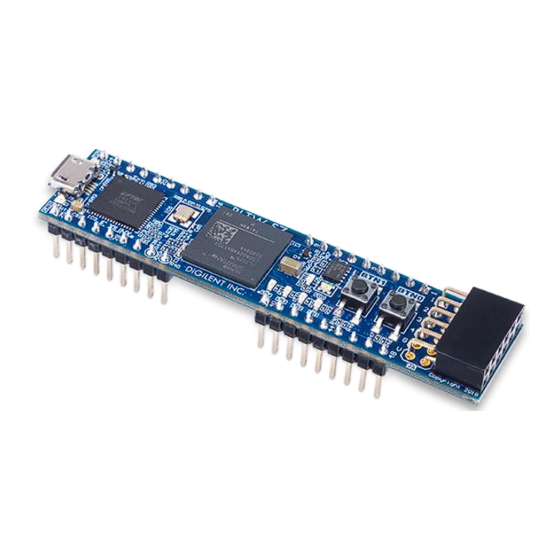Digilent PLTW S7 Podręcznik referencyjny - Strona 4
Przeglądaj online lub pobierz pdf Podręcznik referencyjny dla Płyta główna Digilent PLTW S7. Digilent PLTW S7 11 stron.

PLTW S7 Reference Manual
2
FPGA Configuration
After power-on, the Spartan-7 FPGA must be configured (or programmed) before it can perform any functions. The
FPGA can be configured in one of two ways:
•
A PC can use the Digilent USB-JTAG circuitry (port J5) to program the FPGA any time the power is on.
•
A file stored in the nonvolatile serial (SPI) flash device can be transferred to the FPGA using the SPI port.
Figure 2.1 shows the different options available for configuring the FPGA.
The FPGA configuration data is stored in files called bitstreams that have the .bit file extension. The Vivado
software from Xilinx can create bitstreams from VHDL, Verilog®, or block-level designs.
Bitstreams are stored in volatile memory cells within the FPGA. This data defines the FPGA's logic functions and
circuit connections, and it remains valid until it is erased by removing board power, or by writing a new
configuration file using the JTAG port.
A Spartan-7 25T bitstream is typically 9,935,224 bits. The time it takes to program the PLTW S7 can be decreased
by compressing the bitstream before programming, and then allowing the FPGA to decompress the bitstream itself
during configuration. Depending on design complexity, compression ratios of 10x can be achieved. Bitstream
compression can be enabled within the Xilinx tools to occur during generation and is enabled by default in the
PLTW S7's master XDC file. For more information on how to do this, consult the Xilinx documentation for the
toolset being used.
After successful programming, the FPGA will cause the "DONE" LED to illuminate.
The following sections provide greater detail about programming the PLTW S7 using the different methods
available.
2.1
JTAG Configuration
The Xilinx tools typically communicate with FPGAs using the Test Access Port and Boundary-Scan Architecture,
commonly referred to as JTAG. During JTAG programming, a .bit file is transferred from the PC to the FPGA using
the onboard Digilent USB-JTAG circuitry (port J5). JTAG programming can be performed any time after the PLTW S7
has been powered on. If the FPGA is already configured, then the existing configuration is overwritten with the
bitstream being transferred over JTAG.
Programming the PLTW S7 with an uncompressed bitstream using the onboard USB-JTAG circuitry usually takes
around 2 seconds. JTAG programming can be performed by Vivado's Hardware Manager.
Copyright Digilent, Inc. All rights reserved.
Other product and company names mentioned may be trademarks of their respective owners.
Figure 2.1. Configuration.
Page 4 of 11
